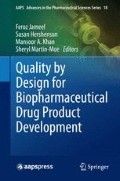Abstract
Mixing processes are complex, multifaceted in nature, and require understanding of fluid dynamics. The relationship between the design of the equipment and solution properties influences the process performance, which in turn impacts the product quality attributes. In this chapter, it is demonstrated through the mock case study how Quality by Design (QbD) elements could be applied to understand all issues and variables characterizing mixing processes and physical properties of the fluid prior to determining optimal operational conditions. Determining optimum operating conditions at production scale is not desirable as it is expensive and time consuming. In this case study, dilution of X-mAb bulk drug substance with diluent/buffer to produce bulk drug product has been chosen to illustrate the mixing characterization study design to identify operating conditions at pilot scale (50 L). The use of models for scale-up coupled with the data obtained at 50 L scale is used to predict operating conditions at the 300 L scale.
Access this chapter
Tax calculation will be finalised at checkout
Purchases are for personal use only
References
Barker JJ, Treybal RE (1960) Mass-transfer coefficients for solids suspended in agitated liquids. AIChE J 6:289–295
Bee JS, Stevenson JL, Mehta B, Svitel J, Pollastrini J, Platz R, Freund E, Carpenter JF, Randolph TW (2009) Response of a concentrated monoclonal antibody formulation to high shear. Biotechnol Bioeng 103:936–943
Brian PLT, Hales HB, Sherwood TK (1969) Transport of heat and mass between liquids and spherical particles in an agitated tank. AIChE J 15:727–733
Gorsky I, Nielsen RK (1992) Scale-up methods used in liquid pharmaceutical manufacturing. Pharm Technol 16:112–120
Harnby N, Edwards MF, Nienow AW (1992) Mixing in the process industries. Buttersworth Heinemann, Oxford
Hughmark GA (1974) Hydrodynamics and mass transfer for suspended solid particles in a turbulent liquid. AIChE J 20:202–204
Levins DM, Glastonbury JR (1972a) Application of Kolmogorofff’s theory to particle-liquid mass transfer in agitated vessels. Chem Eng Sci 27:537–543
Levins DM, Glastonbury JR (1972b) Particle-liquid hydrodynamics and mass transfer in a stirred vessel. 2. Mass transfer. Trans Inst Chem Eng 50:132–146
Maa YF, Hsu CC (1997) Protein denaturation by combined effect of shear and air-liquid interface. Biotechnol Bioeng 54(6):503–512
Norwood KW, Metzner AB (1960) Flow patterns and mixing rates in agitated vessels. AIChE J 6(3):432–437
Oldshue JY (1983) Fluid mixing technology. Chemical Engineering, New York, p 574
Okamoto Y, Nishikawa M, Hashimoto K (1981) Energy dissipation rate distribution in mixing vessels and its effects on liquid-liquid dispersion and solid-liquid mass transfer. Int Chem Eng 21:88–91
Paul EL, Atiemo-Obeng VA, Kresta SM (2004) Handbook of industrial mixing: science and practice. Wiley-Interscience, Hoboken, p 1377
Perry RH, Green DW (2008) Perry’s chemical engineers’ handbook. McGraw-Hill, New York
Tatterson GB (1991) Fluid mixing and gas dispersion in agitated tank. McGraw-Hill, New York
Tatterson GB (1994) Scale-up and design of industrial mixing processes. McGraw-Hill, New York
Wan Y, Vasan S, Ghosh R, Hale G, Cui Z (2005) Separation of monoclonal antibody alemtuzumab monomer and dimers using ultrafiltration. Biotechnol Bioeng 90:422–432
Acknowledgements
I would like to thank Michael Siedler for his review and help in getting this chapter together.
Author information
Authors and Affiliations
Corresponding author
Editor information
Editors and Affiliations
Rights and permissions
Copyright information
© 2015 Springer Science+Business Media, LLC
About this chapter
Cite this chapter
Jameel, F., Wolfrum, S. (2015). A QbD Approach in the Development and Scale-Up of Mixing Processes. In: Jameel, F., Hershenson, S., Khan, M., Martin-Moe, S. (eds) Quality by Design for Biopharmaceutical Drug Product Development. AAPS Advances in the Pharmaceutical Sciences Series, vol 18. Springer, New York, NY. https://doi.org/10.1007/978-1-4939-2316-8_11
Download citation
DOI: https://doi.org/10.1007/978-1-4939-2316-8_11
Published:
Publisher Name: Springer, New York, NY
Print ISBN: 978-1-4939-2315-1
Online ISBN: 978-1-4939-2316-8
eBook Packages: Biomedical and Life SciencesBiomedical and Life Sciences (R0)

